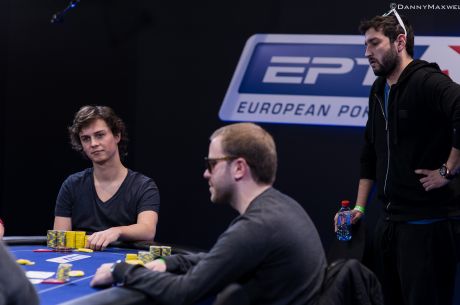Made Hand Makes a Mess; or, Going Crazy With a Pocket Pair

Poker is a game of patience. From time to time we��ve all been in a spot where the deck is running cold and the only thing keeping us focused is the prospect of picking up some semblance of a starting hand. When that happens and we look down at two suitable cards in a solid table position, it can feel like unwrapping a Christmas gift that you��ve waited all morning to get your hands on.
When a patient player picks up a solid starting hand, the first thing on his or her mind is to capitalize on this situation. That being said, sometimes getting too excited by solid preflop holdings can lead to dire circumstances down the road. Let��s take, for example, a hand played on Day 2 during the European Poker Tour Barcelona Main Event from the beginning of this season.
The hand involved EPT8 Prague Main Event champion Martin Finger and came during Level 12 where the blinds were 800/1,600 with a 200 ante.
Action folded to a player in the cutoff who had 219,000 to begin the hand, and he opened with a raise. Finger was on the button with about 183,000, and the German responded with a reraise to 13,000. The blinds let go of their cards and the player in the cutoff came back over the top for 39,000 total. Finger called.
The two took a flop of K?5?2? and the player in the cutoff kept up his aggression with a bet of 40,000. Finger stayed the course and called, then the Q? fell on the turn. At that point Finger��s opponent jammed for about 140,000 total and Finger called all in for his last 104,300.
Finger: K?6?
Opponent: 10?10?
The board finished with the 9?, allowing Finger to double and take a commanding chip lead at that point in the day.
First and foremost, the turn call with merely top pair and a weak kicker was world-class and showcases exactly why Finger is one of the top professionals on the live tournament circuit today. But despite the fact that Finger��s opponent was playing against top-notch talent, that wasn��t the only reason why he lost a majority of his rather large stack in this hand.
At the core of it, Finger��s opponent got attached to a good starting hand. During the preflop stage of the hand, the player in the cutoff opened with a standard raise. Finger three-bet from the button and when action came back around the cutoff made his first mistake.
Rather than flat calling the three-bet before the flop and opting to play a smaller pot with more information, the cutoff comes over the top with a four-bet. While Finger��s opponent may truly have believed he had the better holding and be correct with that assessment a majority of the time (including in this specific instance), the hand was far from over. The four-bet here and willingness to play a large pot with one pair shows the start of behavior that ultimately cripples the cutoff��s stack.
One of the more dangerous aspects to four-betting this hand is the fact that the player was out of position against a world-class opponent. The cutoff is, in essence, bloating the pot and hoping that his hand holds against Finger after the community cards run out. Unfortunately, being out of position means that he will have to act before Finger on every street.
On the flop, the cutoff has little choice but to continue his aggressive streak and lead out. Unfortunately, the pot had become so large before the flop, that ensured his continuation bet had to be a large one. If Finger whiffed the flop and opted to let his hand go at that point, the big c-bet wouldn��t have been an issue. But with an overcard to the tens present, the cutoff would basically be forced to turn his hand into a bluff on subsequent streets if the bet were called.
Finger called the flop with top pair and the aforementioned scenario was exactly what played out. The queen on the turn brought another scare card to the tens, meaning that it was even more likely for his hand to be beat by a higher pair. But with so much money in the pot from his aggression on earlier streets, the cutoff saw the only to move that had potential to win was to shove all in and hope Finger released his cards. The cutoff was correct in assuming that Finger��s hand wasn��t the strongest, but the German��s experience and knowledge at the table allowed him to see through this shove and make the correct call.
One final note that should be mentioned relates to how aggressively this hand was played vis-��-vis the players�� stack sizes. The cutoff started with approximately 219,000 or roughly 136 big blinds. Finger��s stack, on the other hand, was around 114 big blinds. The two players were remarkably deep-stacked, meaning that playing big pots or overplaying starting hands could lead to incredibly unfortunate situations.
The cutoff failed to realize that while playing this deep, it��s rarely ever a good idea to get one��s entire stack all in with one pair. More often than not, the cutoff��s opponent will recognize how deep the stacks are and if he doesn��t back down early will very likely have a superior holding.
In deep-stacked tournament poker, it��s important not to be in too great a hurry to get all of those chips in the middle. Having a lot of chips allows you to play with more caution both before and after the flop, gaining information with smaller bets as you proceed from street to street. In order to achieve maximum information, pot control must be exercised, but that fails to happen when a player becomes married to what looks like a solid starting hand.
Want to stay atop all the latest in the poker world? If so, make sure to get PokerNews updates on your social media outlets. Follow us on Twitter and find us on both Facebook and Google+!








